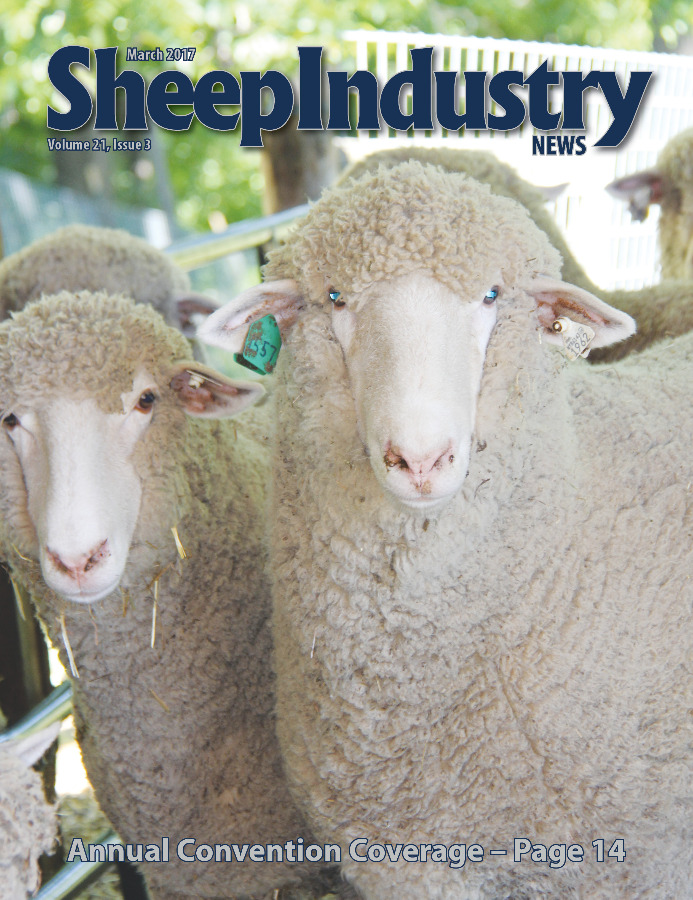
- March 2017
- President’s Notes
- Montana Sheep Conflicts Examined
- ASI Headed to Washington this Month
- Hahn Tops Shearing Field
- Convention: American Wool…Branded for the Future
- Convention: Branding American Wool
- Convention: Officers, Executive Board Elected
- Convention: Industry Veterans Honored
- Convention: Abiding by VFD Regulations
- Convention: States Share Highlights, Challenges
- Convention: Social Media Takes Center Stage
- Convention: FMD Focus of Animal Health
- Convention: WS Aerial Program a Priority
- Convention: Preparing for the New Farm Bill
- Convention: PERC Hears from Researchers
- Convention: EBVs Pay Off for Producers
- Convention: Lamb News is Encouraging
- Convention: The Fleece Awakens at MIWW
- Webinars Prove Informative
- Round 5 of Let’s Grow Grants Open
- Market Report
- The Last Word
Lamb News is Encouraging
KYLE PARTAIN
Sheep Industry News Editor
While goat meat took the place of lamb on many of the top food trend lists for 2016, lamb continued to build a following with restaurants and chefs.
“What I found is that ground lamb is showing up on more menus,” said Mary Humann, a consultant with the American Lamb Board, during the meeting of the ASI Lamb Council in January. “Lamb is most often used as an entree in restaurants, but use of lamb was up 173 percent in the last 10 years in appetizers.”
The use of lamb outside of costly entrees is good news for producers. Consumers unfamiliar with the meat are more likely to try it in less-expensive appetizers first. If they enjoy the lamb that way, then the next time around there is a better chance they will order an entree with lamb.
A 2016 survey showed lamb is used 83.3 percent of the time as an entree. The meat appears 15.5 percent of the time in appetizers and 1.1 percent of the time in side dishes. Just 10 years ago, lamb appeared in appetizers only 6 percent of the time.
“Appetizers are a great way for consumers to try something different,” Humann said. “We’ve also seen that the use of lamb is up in casual dining and quick service restaurants.”
An estimated 40 percent of lamb is sold into food service, and most consumers experience lamb for the first time in a restaurant setting. Traditional cuts – such as racks and chops – appear on 75 percent of fine dining menus, and American lamb continues to dominate the market.
“Chefs tell us they buy American lamb because of the superior taste and to support local farms,” Humann said. “The main reason they’ve used foreign lamb is cost.”
Humann left the audience with three top trends in the food service industry: Mindful menus, authentic ethnic cuisine and casualization. Consumers want to know the story behind the food they are eating, which benefits American ranchers and farmers. They’re also looking for bold flavors as interest in Mediterranean, Spanish and Caribbean cuisines continues to grow. Lamb is a popular meat within these cuisines.
And finally, consumers are trending away from fancy, white table cloth style restaurants in favor of a more laid-back dining approach. With that in mind, continued growth of lamb in fast casual and quick service markets is key to continued growth for lamb.
Colorado State University’s Karissa Maneotis presented the school’s study of lamb flavor. While many who participated in the study claimed to appreciate bold flavors, they were more likely to choose lamb cuts with a mild flavor as their favorites.
Because taste of American lamb can vary dramatically, she said there might come a time when the meat needs to be marketed in mild, medium and bold flavors.
The council also heard from representatives with the U.S. Department of Agriculture on lamb reporting. Such reports have been virtually non-existent in the past year due to consolidation within the industry that has created confidentiality concerns.
Erica Sanko with the California Wool Growers Association has worked with ASI on the issue and says that a one-size-fits-all approach to meat reporting simply won’t work for the lamb industry. USDA’s Agricultural Marketing Service began meetings with meat industry stakeholders last fall and is scheduled to hold a lamb focus group meeting in May 2017.
USDA’s Willy Horne, Ph.D., provided an update on the implementation of instrument augmented lamb grading, which is being used “unofficially” in one plant.
“Based on the progress, we are targeting the first half of 2017 to get an approval,” he said.
James Robb with the Livestock Marketing Information Center provided an update, including the fact that industry saw a dramatic drop in cold storage inventory in 2016.

